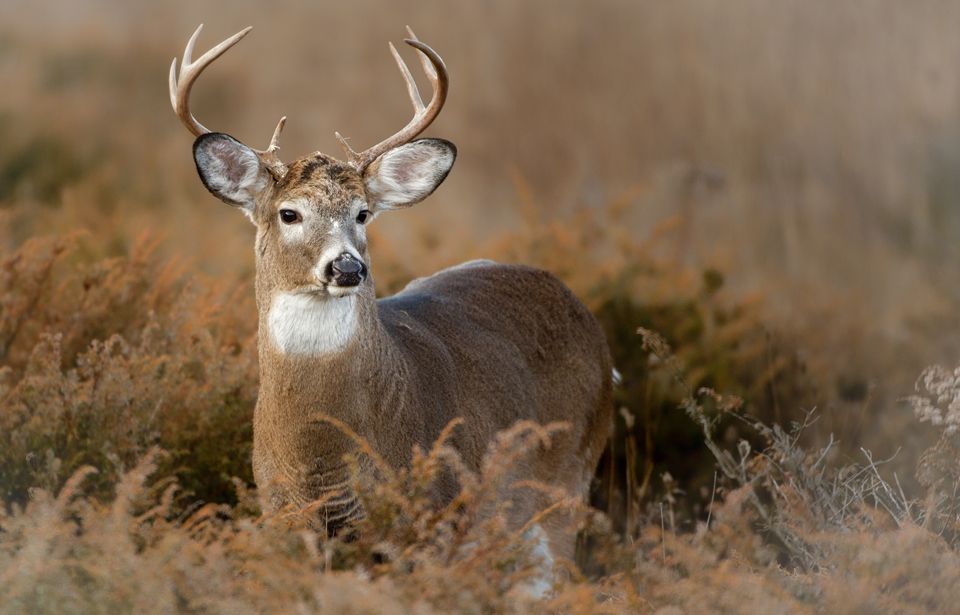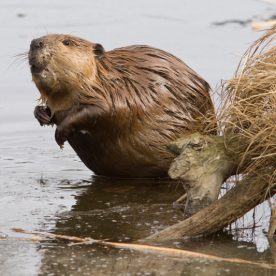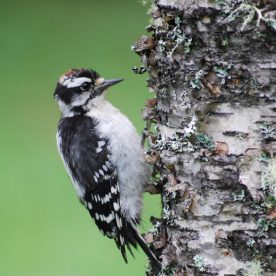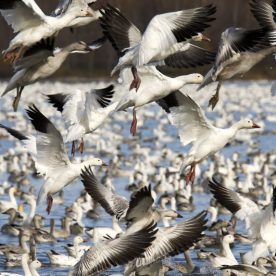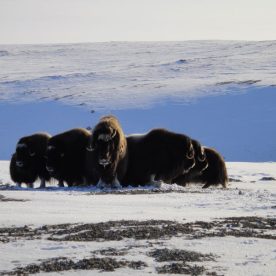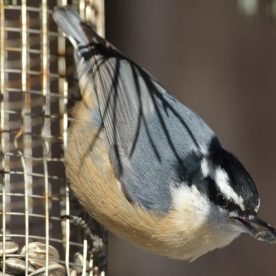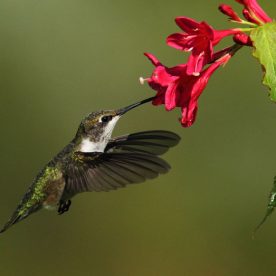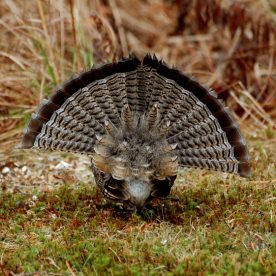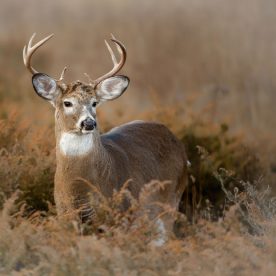Wildlife
- features in the activities of 91 percent of the population, or an estimated 19 million Canadians
- plays a vital role in the ecological and biological processes that are essential to life itself
- is important in the discovery or development of most pharmaceutical products
- plays an impressive part in the Canadian economy
In our lives
Wildlife is important to people
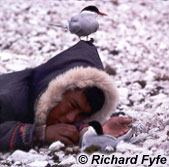
Canadians love and appreciate wildlife. For many of us wildlife provides powerful images that help define the very essence of our country: the cry of a loon echoing across a lonely lake, the power and majesty of a polar bear, great Vs of Canada Geese wheeling in the sky. The experience of wildlife enriches the lives of all Canadians.
Canadians love and appreciate wildlife. For many of us wildlife provides powerful images that help define the very essence of our country: the cry of a loon echoing across a lonely lake, the power and majesty of a polar bear, great Vs of Canada Geese wheeling in the sky. The experience of wildlife enriches the lives of all Canadians.
There are important emotional and social reasons why humans need to experience wildlife and nature from time to time. We all have to recharge our batteries, to get out and breathe a little fresh air. Sometimes simply taking a walk in the park or setting up a backyard bird feeder is enough; at other times we seek more active pastimes such as hiking, hunting, canoeing, or wildlife photography.
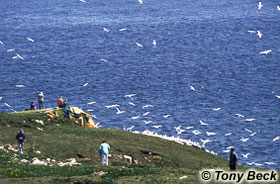
The quality of these experiences is directly related to the quality of our Canadian wildlife and wildlife habitat.
Canadians are starting to learn that wildlife is not merely a source of personal pleasure, as deep and meaningful as that pleasure might be. We are beginning to understand that the health of our wildlife is an excellent indication of the health of the environment on which we depend, and that healthy wildlife populations and habitat are important to our social and economic well-being.

From prehistoric times to the present, the muskox has provided the Inuit with meat, warm sleeping robes, and horn used to make implements and weapons. Inuit also regard the muskox as the source of spiritual gifts, such as a song for hunters.
It is relatively easy to recognize the direct value of wildlife to Canada’s native peoples, who often rely on the wild harvest for food, clothing, and income. For some of Canada’s native populations, over half of their total income comes directly from hunting, fishing, and trapping, while food taken from the bush can account for a high percentage of dietary needs. Wildlife also figures prominently in aboriginal art, legend, and ceremony. Seasonal migrations of wildlife species may be times of intense communal ritual and renewal.
And, even though most Canadians may not depend directly on wildlife for their livelihood as aboriginals do, the role that wildlife plays in their lives is still very important. Through the ages wildlife has inspired such human activities as art, music, dance, drama, story-telling, and poetry. It also plays an important part in our spiritual lives, at the very least reminding us of the complexity and wonder of our world. And millions of Canadians of all ages are hanging out bird feeders, buying special seed mixtures, and volunteering on behalf of wildlife. Witness the more than 10 000 Canadians across the country who take the time to venture out into the snow for the Christmas Bird Count, an annual census to determine numbers and species of birds wintering in Canada.
Statistics Canada, on behalf of the Canadian Wildlife Service and provincial wildlife agencies, carries out an extensive survey on the importance of wildlife to Canadians. The survey asks Canadians 15 years and older about their attitudes toward the importance of healthy and abundant wildlife populations, participation in a number of wildlife-related activities, and wildlife-related expenditures. The survey was carried out in 1981, 1987, and 1991. The 1987 and 1991 surveys also included questions about recreational fishing.
The results of the most recent survey were published by the Canadian Wildlife Service in 1993 and 1994. The survey showed that the great majority of Canadians believe that it is important to maintain abundant wildlife (86 percent of the population) and to protect endangered or declining wildlife species (83 percent). Activities that depend on fish and wildlife were a popular form of recreation for most Canadians. In fact, 91 percent of the surveyed population, or an estimated 19 million Canadians, were involved in some form of wildlife-related activity or recreational fishing. And most of them (73 percent) took part in two or more activities during the year.
Other findings:
- 14.5 million Canadians (70 percent of the population) participated in wildlife-related activities around their residence or cottage. These activities included feeding, watching, studying, or photographing wildlife. Some 6.6 million people put out special feed for wildlife.
- 3.9 million people made trips or outings whose primary purpose was to enjoy wildlife.
- 1.5 million Canadians hunted.
- 5.5 million Canadians participated in recreational fishing.
- 1.9 million Canadians belonged or contributed to wildlife organizations.
- 17.7 million Canadians (85 percent of the population) took part in activities such as watching wildlife films or television programs, reading wildlife books or magazines, visiting game farms, zoos, aquariums, or natural history museums, or purchasing wildlife art, crafts, or posters.
These figures show the dimensions of the attraction that wildlife has for Canadians. Activities that depend on wildlife are a vital part of the everyday lives of an overwhelming majority of Canadians.
In natural processes
Wildlife is important to natural processes
Wildlife and wildlife habitat play a vital role in the ecological and biological processes that are essential to life itself. The functioning of the biosphere, and hence the maintenance and enhancement of human life, depends on countless interactions among plants, animals, and microorganisms.
These ecological processes are essential for agriculture, forestry, fisheries, and other endeavours necessary to human life. They also help maintain environmental quality by degrading and otherwise removing some pollutants and by preventing waste accumulation.
Some of the biological processes in which wild species play a key role are pollinization, germination, seed dispersal, soil generation, nutrient cycling, predation, habitat maintenance, waste breakdown, and pest control. Birds, for example, can be important in controlling insect pests. The Evening Grosbeak’s appetite for larva of the spruce budworm, a serious pest in softwood forests, makes it one of our most beneficial songbirds. Studies have shown that the Hairy Woodpecker and Downy Woodpecker are important in controlling the codling moth in apple orchards in Nova Scotia.
In science, agriculture, and medicine
Wildlife is important to science, agriculture, and medicine

Studies in Nova Scotia have found that woodpeckers destroyed up to 90 percent of codling moth larvae overwintering under the bark of apple trees.
Wildlife and wildlife habitat are also important for the preservation of genetic diversity. Canada’s agriculture, forests, and fisheries all rely on crops or stocks that are adapted to local or regional conditions and that can withstand pests, diseases, predators, pollutants, and other threats. The diverse genetic material present in Canada’s heritage of living resources can help ensure that the forest, crops, and stocks Canadians rely on will remain varied and resilient enough to withstand an ever-increasing list of threats.
Likewise, in medicine, the development of new drugs and treatments depends greatly on wildlife and wildlife habitat. In fact, most pharmaceutical products were discovered or developed by studying wild species, not invented on the basis of the principles of chemistry.
Many modern remedies contain one or more ingredients derived from a wild plant or animal. One familiar example is aspirin. Its active ingredient is salicin, which is found in the bark of willow trees. A more recent example is taxol, a compound derived from the bark of the western yew in the old-growth forests in British Columbia. Taxol damages cancerous cells but not normal ones, and is being used to treat various kinds of cancers. Of Canada’s 134 native tree species, 38 have one or more recorded medical uses according to aboriginal, folk, or modern medical sources.
Frogs may one day be the source of some astonishing medicines. Researchers in Australia, Japan, and the United States have found numerous medical uses for compounds extracted from the secretions of frogs, such as a nonaddictive painkiller 200 times more powerful than morphine, antibiotics, a possible treatment for schizophrenia, and a natural glue that could replace stitches after surgery. The natural world is indeed a potent medicine chest.
In the Canadian economy
Wildlife recreation is important to the Canadian economy
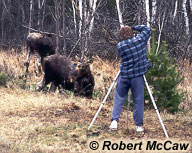
Every spring, migrating songbirds draw thousands of visitors to Point Pelee National Park in southern Ontario. Close to 40 species of brightly coloured warblers visit the park, and so do thousands of bird watchers, who spend almost $6 million a year on accommodation, food, travel, and equipment. The presence of these visitors makes a significant contribution to the local economy. Every fall over 90 000 people visit Cap Tourmente in southern Quebec to view migrating snow geese. This influx of visitors creates seasonal job opportunities and benefits the local economy. Similar benefits accrue in centres where whale watching, polar bear observation, or seabird viewing has become an attraction.

These are just a few examples of the importance of wildlife to a local economy. When expenditures on wildlife-related activities are computed on a national scale, as in the Statistics Canada survey mentioned in Wildlife is important to people, [Create a hyperlink to this section, which appears earlier in this text.]the totals are impressive. Canadians spent $8.3 billion on fish- and wildlife-related recreational activities in 1991. This money went for everything from licence fees for hunting and fishing to binoculars for birdwatching, and from outdoor clothing to transportation and hotels. The economic stimulus provided by these expenditures supported 188 000 jobs, contributed $10.2 billion to the Gross Domestic Product, and put tax revenues worth $4.6 billion into government coffers across Canada. The chart shows the breakdown of these benefits province by province.
The Canadian economy also benefits from the expenditures of foreign tourists who travel to Canada in pursuit of wildlife experiences. For example, nearly 2 million Americans visited Canada for its fish and wildlife in 1991 and spent $842 million, according to a U.S. Census Bureau study. These expenditures created economic benefits additional to those in the following chart resulting from expenditures by Canadians.
Economic impact of expenditures on fish and wildlife-related recreation by Canadians in 1991
|
Expenditures by residents |
Jobs sustained |
Contribution to gross domestic product |
Contribution to government |
Revenue from taxes |
|
Canada |
$8.3 billion |
187 791 jobs* |
$10.2 billion* |
$4.6 billion* |
|
British Columbia |
$1493 million |
30 495 jobs |
$1615 million |
$373 million |
|
Alberta |
$1 159 million |
24 383 jobs |
$1 336 million |
$178 million |
|
Saskatchewan |
$326 million |
7 053 jobs |
$312 million |
$74 million |
|
Manitoba |
$261 million |
7 371 jobs |
$344 million |
$76 million |
|
Ontario |
$3 038 million |
71 997 jobs |
$4 155 million |
$769 million |
|
Quebec |
$1 525 million |
43 880 jobs |
$2 202 million |
$512 million |
|
New Brunswick |
$179 million |
3 674 jobs |
$186 million |
$46 million |
|
Nova Scotia |
$147 million |
3 937 jobs |
$180 million |
$43 million |
|
Prince Edward Island |
$13 million |
574 jobs |
$19 million |
$5 million |
|
Newfoundland |
$198 million |
3 256 jobs |
$171 million |
$70 million |
NOTE: Based on the 1991 national Survey on the Importance of Wildlife to Canadians. For more comprehensive data, see the 1994 report by Filion et al. in Resources.
*The sum of the provincial economic impacts differs from the total for Canada because Statistics Canada uses different input-output models for national and provincial statistics and because revenue from taxes for Canada includes both federal and provincial taxes.
Sustaining the benefits
The sheer scale of the benefits provided by wildlife to individuals and the economy is one more compelling reason for maintaining wildlife populations and habitats in a productive, healthy state. However, wildlife is under stress. Species are disappearing at a faster and faster rate. In 1994, 117 species or population of birds, mammals, reptiles, fish, amphibians, and plants were listed as endangered or threatened in Canada. And wildlife habitat is disappearing even faster as it is drained and cultivated, paved over, or strip-mined as industrialization proceeds apace. One strategy for maintaining abundant wildlife populations is to remind business executives and decision-makers that wildlife resources should be treated as assets to be conserved and managed for the benefit of all humanity. This notion is enshrined in the United Nations Convention on Biological Diversity, which Canada ratified in 1992.
The objective of the Convention on Biological Diversity is “the conservation of biological diversity, the sustainable use of its components and the fair and equitable sharing of the benefits.” Biological diversity, or biodiversity, means the variety of life on earth and includes the entire web of living organisms from soil microbes, plankton, frogs, and trees to grizzly bears and blue whales. The birds and mammals that we have traditionally regarded as wildlife are an important component of biodiversity. Sustainable use is defined in the Convention as “the use of components of biodiversity in a way and at a rate that does not lead to long-term decline” but maintains the “potential to meet the needs and aspirations of present and future generations.” The continued existence of humanity on the planet and the elimination of global poverty depend on recognizing the natural environment, or biodiversity, as the foundation of a sound economy. It is only possible to enjoy economic prosperity now and in the future if a healthy environment is maintained.
From the perspective of sustainable use, wildlife is a renewable resource that provides many benefits and socioeconomic advantages. Canadians have much to gain by treating wildlife and wildlife habitat as the precious resources they are and managing them in such a way that future generations will receive their full benefits in perpetuity.
In order to achieve sustainable use of wildlife, governments, industry, and the general public must exercise care in the way in which they think about the environment and the economy. We must be careful not to purchase short-term economic “prosperity” at the cost of degrading biodiversity. We must remember that the value of a forest lies not only in the timber that can be logged. The standing forest is wildlife and recreational habitat, a purifier of air and preventer of erosion, a possible source of plants and animals with important medicinal properties, and part of the web of biodiversity. Such environmental considerations cannot be considered luxury add-ons, afterthoughts to the planning process. They must be made integral to economic policy making and a required element of any economic development proposal.
Canada is moving toward the goal of managing wildlife sustainably in several important ways. For example, even before the term “biodiversity” came into use, Canada had adopted a wildlife policy that defines wildlife as all wild organisms and their habitats—including wild plants, invertebrates, and microorganisms, as well as fishes, amphibians, reptiles, and the birds and mammals traditionally considered as wildlife. One of the goals of A Wildlife Policy for Canada is “ensuring that all uses of wildlife are sustainable.” The Survey on the Importance of Wildlife to Canadians helps us to understand how these sustainable uses of wildlife can contribute to the well-being of people in perpetuity.
In the 1970s, as many as 100 million waterfowl made the annual migration south from Canada to the United States and other countries. Today, these numbers have declined significantly, primarily because of loss of habitat to other land uses.
Migrating ducks and geese are a spectacular reminder of seasonal rhythms. Approximately 394 000 Canadians hunted waterfowl in 1991, and 5.8 million people enjoyed observing waterfowl. About 30 000 jobs depend on waterfowl-related activities such as tourism, hunting, and waterfowl observation. Considerable social and economic values are therefore at risk when waterfowl populations shrink.
Recognizing the importance of sustaining these benefits, in 1986 Canada and the United States agreed to a North American Waterfowl Management Plan, an ambitious attempt to restore waterfowl populations by protecting and improving the wetlands and grasslands that ducks, geese, and swans need for breeding, nesting, and migrating. In 1994 Mexico joined the plan. An important part of the plan is assisting landowners in managing their lands in ways that will benefit both them and waterfowl. For example, prairie farmers are now increasing beef production as well as the nesting success of waterfowl by fencing pasture into smaller parcels and rotating cattle through the parcels. This way there is no overgrazing, the cattle put on more weight, and waterfowl and other wildlife are able to use parts of the pasture undisturbed. Other wildlife-friendly farming practices include delayed haying and the construction of nesting structures for waterfowl.
Public and private conservation organizations in Canada and the United States have committed themselves to generating the $1.6 billion needed to attain the plan’s objectives in Canada by the year 2010. This is a lot of money, but an excellent investment from the point of view of sustainable use because waterfowl will contribute more than $1.5 billion annually to Canada’s Gross Domestic Product during this period, or more than 20 times the original investment.
The North American Waterfowl Management Plan is an extremely important step in the right direction, but much more can and must be done to ensure that sustainable use becomes the norm.
Wildlife for the future
Canadians cherish wildlife for its own sake. They appreciate it as a resource that adds colour and variety to the world, humbles them to the realization of their interconnectedness with all forms of life, and astonishes by its beauty, strength, and adaptability. Although wildlife has not traditionally been thought of as a major contributor to our well-being, we are becoming increasingly aware of its many important benefits. Even from a strictly economic viewpoint, expenditures on wildlife conservation are justifiable. Dollars spent on wildlife conservation pay themselves back, with interest. As the North American Waterfowl Management Plan demonstrates, the economic costs of letting our wildlife populations languish are far greater than those of protecting them. Wildlife must be managed as a sustainable resource.
Sustainable use is a challenge for us to achieve, but it holds the promise of ensuring that human beings can enjoy both a healthy environment and a healthy economy. The choice is not one or the other. Sustainable use will ensure that the numerous tangible and intangible benefits of wildlife that we enjoy today can be enjoyed by future generations as well.
Resources
Print resources
Burns, S., and Keith, J.A. 1995. Biodiversity. Hinterland Who’s Who. Canadian Wildlife Service, Ottawa.
Filion, F.L., et al. 1993. The importance of wildlife to Canadians. Highlights of the 1991 survey. Canadian Wildlife Service, Ottawa.
Filion, F.L., et al. 1994. The importance of wildlife to Canadians: The economic significance of wildlife-related recreational activities in 1991. Canadian Wildlife Service, Ottawa.
United Nations Environment Program. 1992. Convention on Biological Diversity. Na. 92-7807, 5 June 1992. Nairobi, Kenya.
Wildlife Ministers’ Council of Canada. 1990. A wildlife policy for Canada. Canadian Wildlife Service, Ottawa.
© Her Majesty the Queen in Right of Canada, represented by the Minister of the Environment, 1989, 1991, 1995. All rights reserved.
Catalogue number CW69-4/77-1995E
ISBN 0-662-22937-1
Text: M. Egan, P. Logan, and E. DuWors
Revision: P. Logan, 1995



